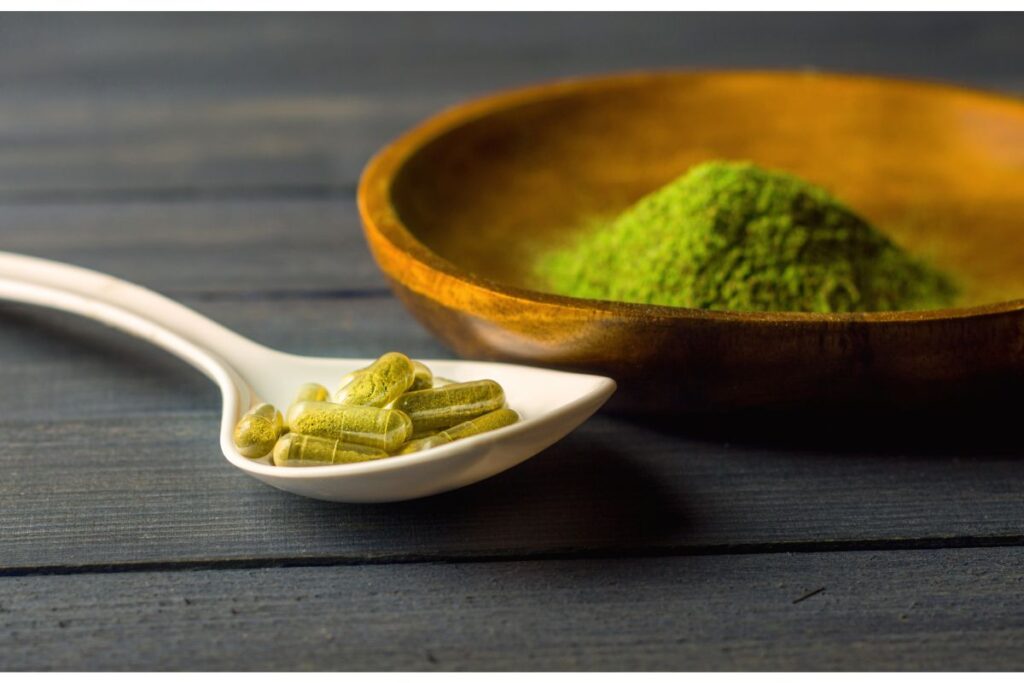Kratom has grown in popularity over the last few years for its potential medicinal properties. Despite its purported benefits, many users have reported experiencing withdrawal symptoms after discontinuing use. While Kratom is not currently a controlled substance, according to the Food and Drug Administration, there is no medical use for the drug. However, Kratom is listed as a drug of concern. This article will highlight in detail what Kratom withdrawal is like, how long Kratom stays in someone’s system, and what Kratom rehab is like.
If you or a loved one is struggling with Kratom addiction, call us now at (470) 460-6789 or fill out the form below and one of our admissions representatives will reach out to you.
What Is Kratom?
Kratom is a tropical evergreen tree native to Southeast Asia, primarily found in countries like Thailand, Malaysia, Indonesia, and Papua New Guinea. The leaves of the Kratom tree have been used for centuries as a traditional medicine to treat various ailments, including pain, anxiety, depression, and opioid addiction.
The primary active compounds in Kratom are mitragynine and 7-hydroxymitragynine, which interact with opioid receptors in the brain to produce effects similar to those of opioid medications. This has made Kratom a popular choice for individuals looking for alternative treatments for pain and opioid withdrawal. However, Kratom is addictive and dependence can develop.

What is Kratom Withdrawal?
Kratom withdrawal occurs when an individual who has been using the substance regularly stops or significantly reduces their intake. The body becomes accustomed to the presence of Kratom and its effects, and when it is no longer available, the user may experience a range of physical and psychological symptoms as their body adjusts to the absence of the substance.
Effects of Kratom Use
Kratom has a range of effects on the body and mind, depending on the dosage and strain. At low to moderate doses, Kratom can have stimulant-like effects, improving energy, focus, and sociability. At higher doses, it can produce sedative and pain-relieving effects, similar to opioids.
However, the use of Kratom also comes with potential risks and side effects, including nausea, constipation, itching, dizziness, and sweating. Additionally, regular use of Kratom may lead to dependency and the development of withdrawal symptoms upon cessation.
Signs and Symptoms of Kratom Withdrawal
Kratom withdrawal symptoms can vary from person to person and may depend on factors such as the duration and frequency of use, the dosage, and the individual’s physiology. Common symptoms of Kratom withdrawal include:
- Anxiety
- Insomnia
- Restlessness
- Muscle aches and pains
- Runny nose
- Sweating
- Tremors
- Irritability
- Depression
- Nausea and vomiting
- Diarrhea
- Cravings for Kratom
According to a 2019 report from the National Institute on Drug Abuse (NIDA), there were 11 deaths between 2011 and 2017 associated with Kratom. Nine out of 11 of those deaths were from polysubstance misuse.

How Long Does Kratom Withdrawal Last?
The duration of Kratom withdrawal can vary, but most individuals report symptoms lasting between a few days to a few weeks. Acute withdrawal symptoms typically begin within 12-48 hours after the last dose and peak within 72 hours. After this point, the symptoms gradually subside over the following days or weeks.
Kratom Withdrawal Timeline
The timeline for Kratom withdrawal can vary based on the individual and the specifics of their use. A general timeline for Kratom withdrawal might look like this:
- Days 1-2: Onset of withdrawal symptoms, including anxiety, restlessness, and muscle aches. Some individuals may also experience flu-like symptoms, such as a runny nose and sweating.
- Days 3-5: Peak of withdrawal symptoms, with increased intensity of physical and psychological discomfort. During this time, individuals may experience heightened anxiety, depression, insomnia, and cravings for Kratom.
- Days 6-14: Gradual decline of withdrawal symptoms, with some lingering symptoms such as anxiety, depression, and cravings. The intensity of these symptoms should begin to decrease, and individuals may start to feel a sense of relief and improvement in their overall well-being.
- Days 15 and beyond: Most individuals will experience a significant reduction in withdrawal symptoms by this point, with some possibly fully resolved. However, some people may continue to experience lingering symptoms, such as anxiety or depression, for several weeks or even months. These individuals may benefit from continued support and treatment to address these issues.
It is important to note that this timeline is a general guide, and individual experiences may vary. Factors such as the duration and frequency of Kratom use, the dosage, and the individual’s physiology can all influence the severity and duration of withdrawal symptoms.
Is Kratom Withdrawal Dangerous?
While Kratom withdrawal is generally considered less severe than withdrawal from opioids or other substances, it can still be challenging and uncomfortable for those experiencing it. In most cases, Kratom withdrawal is not life-threatening.
However, individuals with pre-existing mental health conditions, such as depression or anxiety, may be at an increased risk for exacerbated symptoms or relapse during withdrawal.

How Is Kratom Addiction Treated?
Kratom addiction treatment involves going through progressive stages of treatment to achieve long-term recovery.
Kratom Detox
The first step to treating Kratom addiction is to enter a detox facility. During detox, individuals are medically monitored 24/7 to ensure medical stability.
During this time, healthcare providers may prescribe medications to help manage more severe symptoms or co-occurring conditions, such as anxiety or depression. In addition, counseling and therapy can help individuals address the underlying mental health issues that led to their Kratom use and develop healthier coping strategies.
Cognitive-behavioral therapy (CBT), motivational interviewing, and 12-step programs are some examples of behavioral therapies that may be beneficial during recovery.
Once an individual has completed detox, more often than not, they enter a residential rehab center.
Partial Hospitalization Programming
Partial Hospitalization Programming – or PHP – is an outpatient form of care that takes place five to six days per week for six hours per day. PHP is the highest form of outpatient treatment.
During PHP, clients partake in identifying maladaptive coping mechanisms, building skills to assist them in the real world, and when the treatment day is over, live at home or at a sober living community offsite.
Intensive Outpatient Programming
Intensive Outpatient Programming – or IOP – is an outpatient level of care that allows individuals to continue fulfilling their daily obligations while still receiving support and services necessary to facilitate recovery. Our Intensive Outpatient Programming takes place during the morning or the evening.
IOP is most appropriate for those who have a structured support system at home or who have stepped down from a PHP.
Outpatient Rehab
Outpatient rehab for Kratom is the lowest level of care that we offer at Buckhead Behavioral Health. While we do not directly admit clients into this program, outpatient rehab is utilized as a step-down as the final phase of outpatient treatment.
Outpatient involves one group therapy session per week and one individual psychotherapy session per week if appropriate.

Can The Effects of Kratom Withdrawal Be Reversed?
While long-term use of Kratom can result in liver damage, kidney injury, and cardiovascular issues among others, there is barely evidence to show how Kratom use affects individuals over time. Typically, major withdrawal symptoms subside within 7 days to two weeks, however, those who follow a full continuum for Kratom addiction have shown successful outcomes.
Find Drug Rehab in Atlanta Today
Buckhead Behavioral Health offers premier Kratom rehab to help you get started on the right footing toward recovery. Kratom withdrawal can be extremely excruciating and it’s nearly impossible to recover alone. Our staff can provide you with Psychiatry and medication management, and all the tools you need in order to minimize the discomfort of withdrawal and find recovery. Verify your insurance now or give us a call today at (470) 460-6789.
More About Kratom
How Addictive Is Kratom?
Side Effects of Kratom Abuse
Does Kratom Show Up on a Drug Test?










